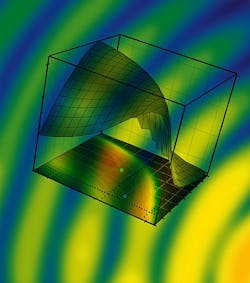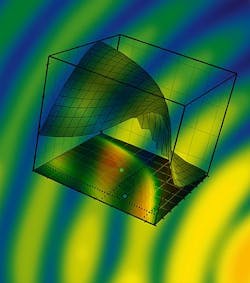Microscopy technique speeds 3D resolution of a sample
A team of researchers from the Institute of Molecular Pathology (IMP) and the Vienna University of Technology (both in Vienna, Austria) has developed a microscopy technique that enhances three-dimensional (3D) resolution. In a simple setup, the researchers used the translation of position information of fluorescent markers into color information. Overcoming the need for scanning the depth of a sample, they were able to generate precise 3D information at the same speed that it would take to acquire a 2D image.
Kareem Elsayad, one of study's co-authors along with Katrin Heinze, used fluorescence microscopy for his experimental setup. In fluorescence microscopy, fluorescent dyes (fluorophores) are turned on by light of a certain wavelength and, as a consequence, âspontaneouslyâ emit light of a different wavelength. Elsayad designed a thin biocompatible nanostructure consisting of a quartz microscope slide with a thin silver film and a dielectric layer. He then labeled the sample with a fluorescent dye and placed it above the coated slide.
Related: Extreme precision in 3D: Adaptive optics boosts super-resolution microscopy
âThe measured emission spectrum of a fluorescent dye above this substrate depends on its distance from the substrate," explains Elsayad. "In other words, the position information of a collection of fluorophores is translated into color information, and this is what we were measuring in the end."
With their method, only one measurement is needed to determine the fluorophore distribution above the substrate, with a resolution down to 10 nm (in the direction away from the substrate). "Once the sample is placed on the substrate, which can be mass-produced, a confocal microscope with spectral detection is all that is needed," explains Heinze.
The novel technique has been tested already by Elsayad and Heinze. Together with collaborators at the Institute of Molecular Biotechnology (IMBA) of the Austrian Academy of Sciences, they used it to study paxillin, a protein important for cell adhesion, in living cells. The scientists also visualized the 3D dynamics of filopodia, small cell protrusions made of bundled actin-filaments that move very quickly and have a high turnover rate during cell migration.
Originally developed for a single fluorescent marker, the new method could be adapted for more efficient DNA sequencing, among other applications, Elsayad says.
Full details of the work appear in the Proceedings of the National Academy of Sciences; for more information, please visit http://www.pnas.org/content/early/2013/11/22/1307222110.
-----
Follow us on Twitter, 'like' us on Facebook, and join our group on LinkedIn
Subscribe now to BioOptics World magazine; it's free!

